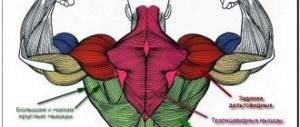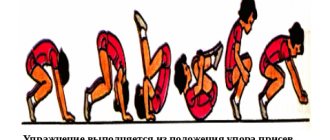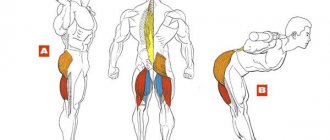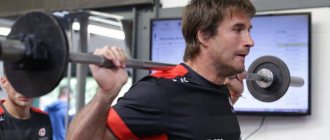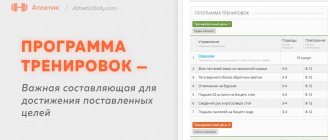Hello, friends. What is circuit training for boxers? By what methods is it carried out? What cycles are present in it, and how long do they last?
The essence of such training is that the necessary volumes of exercise are selected to develop different muscle groups.
Exercises are implemented in a strict algorithm and in one cycle (circle). When it is completed, the boxer pauses for a maximum of 2 minutes and begins the next cycle. On average 5 laps are performed
Exercises should be selected taking into account the training objective and the degree of physical development of the students.
The advantages of such activities
Circuit training in boxing has the following advantages:
- Solid efficiency.
- All muscles are toned.
- Development of endurance.
- The cardiovascular system is strengthened.
- The respiratory organs are strengthened.
- This is the best option for beginners.
- Classes do not take much time. They do not need special conditions and a wide range of projectiles.
Great importance is given to the algorithm for implementing exercises. It is formed according to the scheme of competently changing the load, now on one or another muscle.
The trainer also determines the optimal intensity. The strength of the trainees is distributed throughout the entire training process. Modest loads start first. Gradually they develop.
Each exercise is separated from the next by a pause of 15 seconds.
The optimal frequency for such training is three times a week (minimum).
An example of circuit training in the gym and at home
Since the exercises can be performed in any order, you can create an endless number of combinations and plan each workout according to your goal and equipment availability.
In the gym, performing circuit training is often problematic because you need to quickly move between equipment, and during peak times in the gym this is difficult because there are too many people around wanting to use the same equipment.
You can get some exercise ideas from our article on full body workout examples.
Do not forget that before any physical activity a warm-up is required.
a home workout consist of?
?
- For the upper body: push-ups (including reverse ones), plank (static or dynamic), dumbbell press, crunches
- For the lower body: squat jumps, squats, lunges
- Full body: burpees, lateral raises, ab scissors, superman or boat, jumping rope
- Cardio: shuttle sprints, jump rope, stair running, running with hip raises
Mix one or more exercises from each block for maximum results.
Example of circuit training at home
The exercises for circuit training in the gym will be different. The variability of the loads here is much greater; it is possible to dilute the cardio with strength training or focus on only one of these types.
An example of strength circuit training in the gym:
- Pulldown to the chest on the upper block
- Crunches on a fitball
- Leg press in the machine
- Hyperextension
- Bent-over arm extension with dumbbells
- Lunges with a weight (kettlebell or dumbbells)
- Dumbbell Bench Press
Possible exercise options for circuit training
An example of a circuit cardio workout in the gym:
- Walk at a moderate pace on a treadmill or exercise on a stationary bike (20 minutes)
- Classes on an orbitrack or stepper (30 minutes)
- Doing exercises on a rowing machine
What to do to avoid getting bored during training? If you always do a circuit of exercises in the same order, at a minimum, start mixing them up differently to challenge your body and trick your brain.
Let's summarize! Basic rules for circuit training:
- Choose 5-7 different aerobic and anaerobic exercises.
- Perform them one after another without a break or with a minimum interval (10-20 seconds). Each exercise is performed with a certain number of repetitions or for a specified period of time.
- Rest no more than 1-3 minutes between circles.
- The number of approaches depends on how many exercises need to be performed in 1 cycle. On average, circuit training lasts 30 minutes.
Contraindications
As with any physical activity, negative consequences most often occur in people with health problems, as well as if the exercises were selected without the participation of a trainer.
Who should choose other types of training?
- Suffering from joint diseases and people with musculoskeletal problems
- People with cardiovascular disorders
- Those with recent injuries or previous surgeries
- Pregnant and postpartum women
The risk of injury from training is minimal, provided that a person does not experience pain during sports.
Another option is to participate in group classes. This is a great way to try new exercises in a group of like-minded people. Here you get good motivation for work, a clearly structured work plan and monitoring of the correct execution of the exercises.
Exercises at home
The circuit training program for boxers at home consists of 6-10 cardio exercises and strength training. The whole body is loaded.
Actions are carried out in several alternating approaches with a pause of up to 15 seconds.
The minimum number of repetitions is 10. You can work on a count, or based on time. Pause after each lap: 1-2 minutes.
Total lesson duration: 30-40 minutes.
The following is the optimal method for beginners.
Simple program. It consists of:
- Warm-ups. You need to walk quickly in place. Spread your arms to the sides. Duration – 20 sec.
- Pull-ups. If you don’t have a horizontal bar, you can do push-ups from a chair or bench. Duration – 40 sec. The number of times is the maximum possible.
- 30 squats.
- Push-ups again, but only from the floor. Duration – minute. The number of times is the maximum.
- Lunges with legs to the sides. Do this 15 times with each leg.
- Position: lying on your back. 20 body lifts.
- Run in place for a minute.
The circle is performed at an intense pace. This cycle must be repeated at least 3 times. It is also necessary to implement a strength program.
What is circuit training
In circuit training, you perform several exercises in a row for different muscle groups, and then start over. In this case, rest between approaches is minimal or absent altogether.
For example, instead of doing 3 sets of 10 push-ups, 3 sets of 20 squats, and 3 sets of 20 crunches, you do 10 push-ups, then 20 squats, 20 crunches, rest for 1-2 minutes, and then repeat 2 more times. times.
In a normal workout, rest between sets is necessary: tired muscles need to rest, otherwise you will not finish the set. In the circuit system, rest is not necessary, because each new approach involves a different muscle group.
Strength program
There are 9 main exercises here. They are performed in three cycles. The cycles are repeated three times. Required equipment: a pair of dumbbells or weights. Their mass is selected based on your physical potential.
Cycle 1 includes the following exercises:
- Starting position – plank. Dumbbells in hands. Hands are raised one by one. The entire body turns upward. The hips do not change position. Number of repetitions – 15.
- Position – standing on the left leg. The right one bends at the knee and rises. The position of the hands is parallel to the floor. They are bent at the elbows - 90 degrees. The lower arm rotates. The number of repetitions for one leg is 15.
- Position: feet stand shoulder width apart. Dumbbells in both hands. Squats follow. The back is straight. Hips are parallel to the floor. As you rise from a squat, press the weights upward. Number of repetitions – 15.
In the second loop you need to do the following:
While in a lying position on your back, spread your arms holding dumbbells. Legs bend 90 degrees. The lower back is pressed to the floor. The arms are raised and brought together, spread to the sides. Forearms are raised above the floor. This way the chest is loaded better. Number of repetitions – 15.
In the third cycle the following exercises:
- Curl dumbbells while holding them in your hands. You should sit on the floor and bend your knees and raise your legs so that your heels are not on the floor. The projectile is held at the shoulder line. The body is retracted.
The upper side of the body rotates to the left. Hands with projectiles are placed on the left thigh. You need to do the same with the right side. Repetitions – 15.
- Position – standing, straight. Dumbbells in both hands. The feet are placed side by side. Hands rise to shoulders. Palms facing each other. The knee of the left leg bends 90 degrees. The right leg is placed back. Her knee doesn't touch the floor. Hands rise up in one phase. The number of repetitions for one leg is 15.
Circuit training method
The circular method (training) is an organizational and methodological form of work that involves the continuous, sequential implementation of a specially selected set of physical exercises for the development and improvement of strength, speed, endurance and especially their complex forms - strength endurance, speed endurance and speed strength.
The goal of circuit training is to achieve high performance of the body by training the neuromuscular system, cardiorespiratory and other systems in regular rotation. Strict implementation of specific exercises, selected in a certain way and concentrated in a given time, ensures the rapid development of motor qualities in a short time. The basic principle of circuit training is that it cannot be reduced to any particular method, but is an organizational and methodological form that includes a number of private methods of using physical exercises.
In circuit training, football players are divided into small groups (3-6 people), the practitioners move from performing one exercise to another, from apparatus to apparatus, from one place of execution to another, moving as if in a circle. Having completed the last exercise in a given series, they return to the first, thus completing the circle. The name of such training – “circular” – is purely conditional.
There are several options for circuit training:
1. Using the method of long-term continuous exercise. Classes are held without breaks and consist of one, two or three rounds. They are mainly used to develop general and strength endurance.
2. Using the extensive interval exercise method. It is used to improve general, speed and strength endurance, speed and strength qualities.
3. Using the intensive interval exercise method. It is designed to improve speed strength, maximum strength, speed and strength endurance.
4. Using the repeated exercise method. It is proposed to be used to develop maximum strength and speed endurance.
To do circuit training in advance:
– a set of exercises is compiled;
– determine the places where the exercises will be performed (“stations”);
– in the first lesson, tests are carried out for the maximum test (MT) for each exercise, provided they are performed correctly;
– establish a system for increasing the load from lesson to lesson;
– at the last lesson, it is recommended to check the maximum test for each exercise and compare the results obtained with the original ones.
Means for circuit training can be very diverse: general developmental exercises and special ones, usually technically uncomplicated. They can be cyclic or acyclic. Exercises are selected depending on the objectives of the lesson, the motor capabilities of the individual and taking into account the transfer of physical abilities and motor skills.
In a complex aimed at comprehensive physical development, there are usually no more than 10–12 exercises, in a complex with a special focus – no more than 6–8. Exercises can be performed on sports equipment (parallel bars, horizontal bars, rings) or using sports equipment and devices (medicine balls, dumbbells, barbells, rubber shock absorbers, block devices). For a clearer organization of classes, it is advisable to mark and direct transitions with chalk on the floor, or even better, place a special card near each “station” with the number and graphic image of the exercise.
Despite all the positive aspects of circuit training, it cannot be considered as a universal method that can replace all others. It should be used with other organizational and methodological forms, including in individual classes, in this case taking up part of the time (30–35 minutes).
In circuit training, as a rule, 6-12 stations are used with specific exercises at each of them, in which the players sequentially perform the proposed work.
Before starting circuit training, you should warm up. Inventory must be arranged in advance at stations. The coach must go through all the stations with the players and demonstrate all the exercises. The number of groups corresponds to the number of stations. During game exercises, you can combine groups. It is not advisable to offer completely new sets of exercises in each circuit training, since considerable time will be spent on mastering them and the effectiveness of the impact of these exercises on the body will significantly decrease. Mastering the exercises and the order of passing the stations occurs in one or two lessons, and then the training proceeds at a good level.
Thus, the analysis of the studied literature on the topic of final qualifying work allowed us to draw the following conclusions. Strength in its pure form is manifested to a small extent in the competitive activity of football players. Therefore, when developing the strength of 15-16 year old football players, the coach should consider it as a basis for developing and improving speed-strength qualities.
The main method of developing strength in football players is the method of repeated effort. Its essence lies in the fact that football players perform an exercise (for example, lifting a barbell or squatting with a barbell) with a weight of 60–80% of the maximum possible. Moreover, the number of repetitions of one series should not exceed 10–12, and the number of series should not exceed two or three. The last repetitions are the most effective. This method allows you to selectively influence the development of strength of different muscle groups.
To develop strength qualities in football players aged 15–16 years, it is advisable to use the circuit training method, which provides a complex effect on various muscle groups. Exercises are carried out at stations and selected in such a way that each subsequent series includes a new muscle group in the work. The number of exercises affecting different muscle groups, the duration of their execution at stations depend on the tasks solved in the training process, the age, gender and preparedness of the trainees.
Soviet template
Circuit training of boxers in the USSR was implemented according to the following template - algorithm:
- Jumping over a bench. This is an activity to develop your calves and foot ligaments. It also helps you maintain balance better.
- Implementation of direct strikes with resistance. The pace is set individually. Wall blocks or bundles are used for work.
- Abdominal swing in a lying position on the floor. Body tilts are combined with a sharp exhalation in the last position.
- Working with a barbell: the projectile is thrown forward in a standing position. This is how the explosive potential and dynamics of action of the arm muscles develop. The mass of the projectile is individual. The projectile must be held with your fingers on the chest line. An explosion is required. It is associated with initial muscle tension.
- Jumping on the bench and shadowboxing. This is the development of the explosive potential of the leg muscles. It is important to maintain the shortest possible contact between your feet and the surface during landing. When taking off, the jump is made to the maximum possible height.
- Working with a heavy ball (medicine ball). He throws himself forward from the shoulder. This improves hand dynamics and coordination. The pace is intense.
- Somersaults. With their help, vestibular stability is improved.
- Working with a floor bar. The projectile is pushed forward with one or the other hand. This is the development of endurance of the arms and lateral muscles of the body. The starting position is a classic stance. The process builds on the initial powerful acceleration without a swing.
- Another jump, but only over the goat. Coordination develops here, and the fighter learns to scrupulously calculate movements in terms of power, vector and dynamics.
- Working with a sledgehammer. She needs to hit the truck tire. This way the arm joints become more mobile and the elasticity of the muscles improves. The blow must be combined with sharp exhalations.
This is a general physical training cycle in circuit training for boxers. But profile systems that work on boxing equipment are also required.
Here in the round robin system the following points appear:
- Pneumatic type bulb. This is the development of better dynamics and coordination.
- Working with a heavy bag. Development of strength, endurance and speed of strikes.
- Working with a hanging bag. Improving coordination and dynamics of movements, and accuracy of strikes.
- Working with a light bag. Improving the technique of performing side kicks.
- Movement. Improved leg coordination.
- Carrying out powerful direct targeted strikes on a wall pad. This is how a specific sensation of impact develops.
- Air strikes. They are performed while holding dumbbells in your hands. The work must be explosive. Impacts have maximum initial acceleration without swinging.
- Dives. This is an improvement in vestibular stability.
- Working with a blower. Direct and lateral attacks are honed here. The sense of distance, coordination and dynamics improves.
All points must be completed at high speed and in compliance with technique.
Methodological recommendations for the development of general physical fitness using the circular training method.
General physical training (GPP) is understood as an educational process aimed at the comprehensive development of a person’s physical qualities. Unlike other types of training in general physical training, the development of physical qualities is carried out with the aim of achieving and maintaining an optimal level of general performance, maintaining high functional activity and social activity. The main tasks solved in the process of general physical training, including independent forms of organizing classes, are:
- increasing the functionality of the main vital systems of the body - breathing, blood circulation, energy supply;
- increasing the level of development of basic physical qualities (strength, speed, endurance, flexibility, agility-coordination);
- increasing the adaptive properties of the body to the socio-ecological and climatic conditions of the human environment;
- increasing the body’s protective functions, resistance to mental illness, mental stress and stress;
- ensuring a person’s functional readiness for professional-applied physical training, including the development of new forms of movements in the form of professional activities, increasing the professionally specified level of special performance.
Planning of general physical training is carried out on the basis of the results of monitoring the physical fitness of students, based on the results of the development of basic physical qualities and includes:
- selection of physical exercises based on their impact on the functional activity of organs and systems of the body;
- choosing the amount of load, its volume and duration, both in a single lesson and in a system of lessons;
- planning classes for weekly, monthly, semi-annual and annual periods.
Circuit training method
The technique of circuit training (CT), the material for which is mainly technically simple exercises, mostly has an acyclic structure. They are given a cyclical character through serial continuous repetitions. The simplicity of the movements allows them to be repeated many times, and the movements themselves are selected according to the scheme so as to ensure a consistent effect on the main muscle groups and provide sufficient load on all internal organs. Repeated loading at the next station should not involve with greater intensity the muscle groups that carried the maximum force at the previous station. The basis of circuit training is the repeated execution of prescribed movements, actions under conditions of precise dosing of the load and the exact order of its change and alternation with rest. When using circuit training in classes, it is necessary to individually select the load corresponding to the level of abilities and physical fitness of each person. For cyclic planning, complexes are used primarily aimed at general physical training.
When developing general physical training using the circuit training method, it is necessary to:
1. Determine the ultimate goals of physical qualities, their development at a specific stage of training.
2. Analyze the exercises, connect them with the educational material, taking into account their positive and negative significance for a particular skill.
3. The set of exercises must fit into a certain part of the lesson, taking into account the degree of physical fitness of the students.
4. Determine the amount of work and rest at stations when performing physical exercises, taking into account age, gender and level of physical development.
5. Strictly observe the sequence of execution and transition from one to another, as well as the interval between circles.
6. Use visual aids.
The main essence of circuit training is that the volume of the simulated complex is subject to standardized implementation in a strictly specified time interval, a certain sequence, with a gradual transition to progressive loads, taking into account the individual characteristics of physical development.
The main task of using the method of circular training in a lesson is the effective development of motor qualities under conditions of a limited and strict time limit with strict regulation and individual dosage of the exercises performed. At the same time, the development of motor qualities should be closely related to the mastery of program material. Therefore, circuit training complexes include physical exercises that are similar in structure to the changes and skills from the sections of the curriculum. This helps improve skills. A prerequisite is preliminary study of these exercises. Circuit training helps to increase the density of exercise and has a positive effect on the body as a whole. The effectiveness of load concentration allows you to successfully develop general and special training in the shortest possible time. The uniqueness of circuit training lies in its differentiation, which allows for an individual approach to everyone, depending on the level of their physical development and relaxation under a given load. To do this, it is enough to choose the optimal ratio of work and rest (pauses) between circles during training.
Circuit training is based on three methods:
- Continuous-flow - exercises are performed one after another with a short interval for rest. This method promotes the development of motor skills.
- Flow-interval - simple exercises are performed for 20-40 seconds with minimal rest, while reducing the control time for completing laps. This method develops general and strength endurance.
- Intensive-interval - when reducing the time of work at stations to 10-20 seconds and maintaining the rest time to 30-40 seconds. This method is aimed at developing maximum and explosive strength.
Pedagogical analysis of “training” classes using the circular training method showed that the motor density of classes reaches 70%, motor activity per class is 2200-3320 steps. Increasing physical activity in circuit training is achieved by increasing the applied external weights (medicine balls, dumbbells, etc.), changing the starting position, and reducing rest intervals between stations. Circular training promotes a more pronounced positive increase in physical fitness indicators, acquisition of knowledge, skills, and regulation of mental state, which is important for maintaining health.
Tyson Circles
Many famous boxers train according to personal programs. For example, Mike Tyson's circuit training program in his youth included the following items:
- Shop. On it he lifted his torso 100 times.
- 50 push-ups behind your back.
- 50 classic push-ups. At the same time, a wide grip is maintained.
- 50 throws of a 30 kg barbell.
